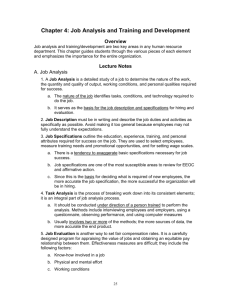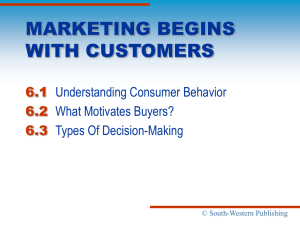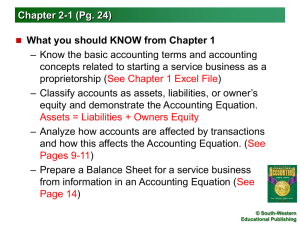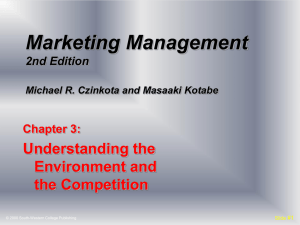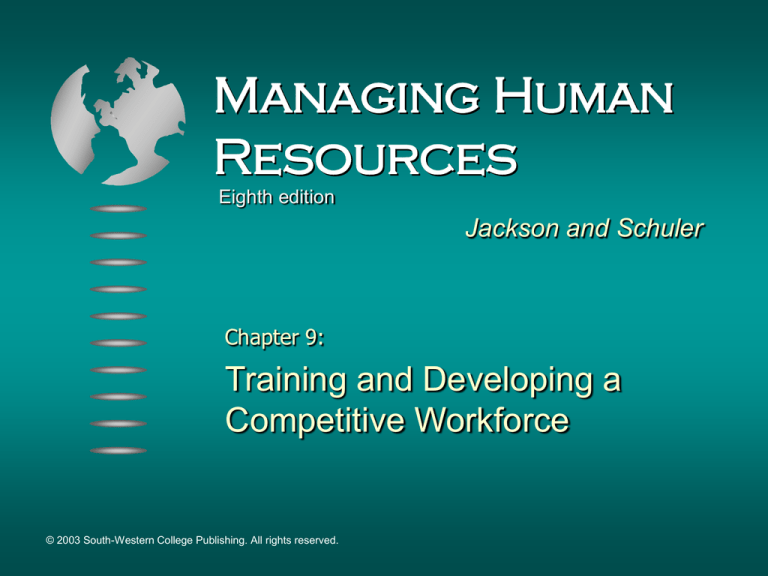
Managing Human
Resources
Eighth edition
Jackson and Schuler
Chapter 9:
Training and Developing a
Competitive Workforce
© 2003 South-Western College Publishing. All rights reserved.
Chapter Outline
Training and Development Practices within
the Integrated HR System
The Strategic Importance of Training and
Development
The HR Triad
Determining Training and Development Needs
Setting Up a Training and Development
System
© 2003 South-Western College Publishing. All rights reserved.
9–2
Chapter Outline (cont’d)
Developing Program Content
Choosing the Program Format
Maximizing Learning
Team Training and Development
Cross-Cultural Training
Evaluating Training and Development
© 2003 South-Western College Publishing. All rights reserved.
9–3
Training and Development Practices
within the Integrated HR System
Training and Development
Intentional efforts to improve
current and future performance
By helping employees acquire
• Skills
• Knowledge
• Attitudes
Required of a competitive
workforce
© 2003 South-Western College Publishing. All rights reserved.
9–4
Key Terms
Training
Improving employee competencies needed today
or very soon
Typical objective is to improve employee
performance in a specific job.
Development
Improving employee competencies over a longer
period of time
Typical objective is to prepare employees for future
roles.
© 2003 South-Western College Publishing. All rights reserved.
9–5
Key Terms (cont’d)
Socialization
Learning how things are done in the organization
• Objective is to teach new employees about the
organization’s history, culture and management
practices.
© 2003 South-Western College Publishing. All rights reserved.
9–6
Learning Organizations
Learning recognized as a source of
competitive advantage
Use knowledge management:
Make sure knowledge from employees, teams, and
units is captured, remembered, stored and shared
Technologies provide software to
share knowledge electronically
Chief Learning/Knowledge Officer
coordinates activities
© 2003 South-Western College Publishing. All rights reserved.
9–7
Training and Development within
an Integrated HR System
Other HR Activities
Needs Analysis
• Fairness/legal
• HR Planning
• Job Analysis
• Recruitment
• Selection
• Measuring
Performance
• Organization
• Job
• Person
• Demographic
Global Environment
• Focus
• Who receives?
• Who delivers?
• Where and when?
• What methods?
• Content
• Labor Market
• Technology
Organizational
Environment
Key Design
Choices
© 2003 South-Western College Publishing. All rights reserved.
Outcomes
•Attitudes
•Skills
•Behavior
•Performance
•Advancement
•Retention
Evaluation
and Revision
9–8
The Strategic Importance of Training
and Development
Socialization
Training
Development
© 2003 South-Western College Publishing. All rights reserved.
• Competencies that match
strategy
• Cohesiveness and
commitment
• Improved recruitment and
retention
• Improved performance
• Legal compliance and
protection
• Smoother mergers and
acquisitions
9–9
Improving Performance
Improving Service
Training for Customers
Productivity
New Technology
© 2003 South-Western College Publishing. All rights reserved.
9–10
Roles and Responsibilities in
Training and Development
Line Managers
HR Professionals
Employees
• Link business plans
to TandD
• Identify needs, with
line mgrs
• Participate in
delivery
• Help employees to
identify needs
• Accept
responsibility for
finding opportunities
• Help employees
identify needs
• Communicate TandD
opportunities and
consequences
• Actively participate
in TandD activities
• Support employee
participation
• Reinforce transfer of
learning
• Do OTJ training
• Develop/administer
TandD activities
• Train trainers
• Evaluate
© 2003 South-Western College Publishing. All rights reserved.
• Identify own needs
• Assist with TandD of
coworkers
• Participate in
evaluation of TandD
activities
9–11
Partnership Perspective
Managers
Identify
Accept
Participate
Cooperate
Support
Train
HR
Employees
Professionals
© 2003 South-Western College Publishing. All rights reserved.
Assist
Communicate
Train
9–12
Determining Training and
Development Needs
Organization
Needs
Job
Needs
Person
Needs
Demographic
Needs
© 2003 South-Western College Publishing. All rights reserved.
9–13
Organizational Needs Analysis
Assess short-and longterm strategic objectives
Analyze:
Human resource needs
Efficiency indices
Training climate
Resources and constraints
Clearly state T and D
objectives
© 2003 South-Western College Publishing. All rights reserved.
9–14
A Supportive Training Climate
Incentives encourage employees to
participate
Managers make it easy for employees to
attend T and D programs
Employees encourage each other
Use of new competencies is rewarded
No hidden punishments for participating
Managers who are effective trainers are
rewarded
© 2003 South-Western College Publishing. All rights reserved.
9–15
Job Needs Analysis
Identify specific skills,
knowledge and behavior
needed in present or
future jobs
Use job analysis with
competency modeling
© 2003 South-Western College Publishing. All rights reserved.
9–16
Person Needs Analysis
Identify the gap between
© 2003 South-Western College Publishing. All rights reserved.
current capabilities and
those that are
necessary or desirable
using:
Output measures
Self-assessed training
needs
Career planning
discussions
Attitude surveys
9–17
Demographic Needs Analysis
Determine needs of
specific populations of
workers
May be used to
determine if all are
given equal access to
growth experiences and
developmental
challenges
© 2003 South-Western College Publishing. All rights reserved.
9–18
Training and Development Process
Assessment
Phase
Assess needs:
• Organizational
• Job
• Person
• Demographic
Training and
Development Phase
Evaluation
Phase
• Select training media
and learning
principles
• Conduct training
• Establish conditions
for maintenance
• Develop
criteria
• Pretest
• Monitor
training
• Evaluate
© 2003 South-Western College Publishing. All rights reserved.
9–19
Setting Up a Training and
Development System
Creating the Right Conditions:
Insight
Motivation
New skills and knowledge
Real World Practice
Accountability
© 2003 South-Western College Publishing. All rights reserved.
9–20
Who Provides Training
and Development?
Supervisors and other managers
Coworkers
Experts
Employee
(e.g., self-paced instruction)
© 2003 South-Western College Publishing. All rights reserved.
9–21
Developing Program Content
Affective
Outcomes
Cognitive
Knowledge
Program
Content
Skill-Based Outcomes
© 2003 South-Western College Publishing. All rights reserved.
9–22
Cognitive Knowledge
Includes:
Information people have
(what they know)
The way people organize
information
Strategies for using
information
Most training addresses
what people know.
© 2003 South-Western College Publishing. All rights reserved.
9–23
Topics Covered by Training Focusing on
Cognitive Knowledge
Company Policies and Practices
e.g., orientation programs
Basic Knowledge and
the Three Rs
The Big Picture
Organization structure,
products, services, business
strategies and environment
© 2003 South-Western College Publishing. All rights reserved.
9–24
Training for Skills
Skills demonstrated by behaviors
Learning involves practicing desired behaviors
For example:
Technical skills
Motor skills
Communication skills
Leadership Skills
© 2003 South-Western College Publishing. All rights reserved.
9–25
Training for Affective Outcomes
Objective Is to Change
Motivation
Attitudes
Values
Example of Objectives
Build team spirit
Enhance self-confidence
Build emotional intelligence (self-awareness, selfmanagement, social awareness, relationship
management)
© 2003 South-Western College Publishing. All rights reserved.
9–26
Choosing the Program Format
Traditional Formats
On-the-job
On-site, but not on-the-job
Off the job
E-Learning
New technology allows integration
of multiple learning methods
Includes teleconferencing, multimedia, computerbased learning
Can speed communication and cut costs
© 2003 South-Western College Publishing. All rights reserved.
9–27
On the Job Training
Job instruction training
Apprenticeship training
Internships and
assistantships
Job rotation and
developmental job
assignments
Supervisory assistance
and mentoring
Coaching
© 2003 South-Western College Publishing. All rights reserved.
9–28
Components of a Developmental Job
Unfamiliar
© 2003 South-Western College Publishing. All rights reserved.
responsibilities
Responsibility for
creating change
High levels of
responsibility
Boundary-spanning
requirements
Dealing with diversity
9–29
On-Site, but Not On the Job Training
Programmed instruction
on intranet or internet
Videos and CDs
Interactive video training:
Combines programmed
instruction with video
Teleconferencing
Corporate Universities
and executive education
© 2003 South-Western College Publishing. All rights reserved.
9–30
Off the Job Training
Formal courses
Simulation
Vestibule method:
simulates actual job
Assessment centers
Role-playing
Business board games
Sensitivity training
Wilderness trips and
outdoor training
© 2003 South-Western College Publishing. All rights reserved.
9–31
Program Location
Job instruction
Apprenticeship
Internships
Job rotation
On-Site, not On-the-Job
Formal courses
Simulation
Assessment centers
Role playing and sensitivity training
Wilderness trips
© 2003 South-Western College Publishing. All rights reserved.
On-the-Job
Programmed instruction
Interactive video and
web-based training
Teleconferencing
Off the Job
9–32
Maximizing Learning
Setting the Stage for Learning
Increasing Learning During Training
Maintaining Performance after Training
Following up on Training
© 2003 South-Western College Publishing. All rights reserved.
9–33
Setting the Stage for Learning
Provide clear instructions
Model appropriate behavior
© 2003 South-Western College Publishing. All rights reserved.
9–34
Increasing Learning During Training
Provide active participation
Increase self-efficacy (trainee’s beliefs about
task-specific ability)
Match techniques to trainee self-efficacy
Provide opportunities for enactive mastery
Ensure specific, timely, diagnostic and
practical feedback
Provide opportunities for practice of new
behaviors
© 2003 South-Western College Publishing. All rights reserved.
9–35
Enactive Mastery
Processes That Increase Self-Efficacy
Experiences that fail to validate fears
Competencies that are developed
Once-threatening situations that are mastered
Methods to Achieve Enactive Mastery:
Task segmentation
Shaping
Use of proximal goals
© 2003 South-Western College Publishing. All rights reserved.
9–36
Maintaining Performance After Training
Develop learning points
to assist retention
Set specific goals
Identify reinforcers
Train significant others
to reinforce behavior
Teach trainees selfmanagement skills
© 2003 South-Western College Publishing. All rights reserved.
9–37
Following Up on Training
Evaluate Effectiveness
Make revisions as needed
© 2003 South-Western College Publishing. All rights reserved.
9–38
Team Training and Development
Training to develop team cohesiveness
Training in team procedures
Training to develop work team leaders
Supporting disagreement
Managing meetings
© 2003 South-Western College Publishing. All rights reserved.
9–39
Cross-Cultural Training
To prepare people from
several cultures to work
together
Diversity training
To prepare a person for
living in another culture
Training for expatriates
and families
© 2003 South-Western College Publishing. All rights reserved.
9–40
Diversity Training in the U.S.
Cultural Awareness Training
How own culture (ethnic background, age,
socioeconomic status, religion, etc.) differs from
that of other workers
Understanding impact of stereotypes
Building Competencies
Practice interpersonal skills
Supplements to Diversity Training
Considering diversity in all aspects of HR
management (recruitment, selection, rewards)
© 2003 South-Western College Publishing. All rights reserved.
9–41
Cross-Cultural Training in
International Context
Training for Expatriates and Their Families
Typically 3-5 day immersion course in country’s
values, customs, traditions
Culture-general assimilator uses scenarios to teach
understanding of cultural differences
Training for Inpatriates
• Employees from other countries
sent to work in U.S.
• Need info about culture and
help with relocation
© 2003 South-Western College Publishing. All rights reserved.
9–42
Global Leadership Training and
Development
Managers need to
manage operations in
several countries at
once
Training and
development may
include:
Expatriate assignments
Action learning projects
Cross-cultural team
assignments
Classroom training
© 2003 South-Western College Publishing. All rights reserved.
9–43
Evaluating Training and Development
Short-Term Effects:
Reactions to TandD activity
Learning (tests)
Changes in behavior and attitudes
Performance on a task
Most frequently used
© 2003 South-Western College Publishing. All rights reserved.
9–44
Evaluating Training and Development:
Long-Term Consequences
Organizational
Improved
productivity
Lower cost
Improved customer
service
Improved retention
Increased applicant
pool
© 2003 South-Western College Publishing. All rights reserved.
Individual
Reduced stress
Increased job
satisfaction
Career advancement
Family satisfaction
Employability
9–45
Evaluation Designs: Experimental Design
T1 X T2
T1 T2
This is the most sophisticated design
• Randomly assigned treatment group participates in
training
• Control group does not participate
• Both groups assessed at time 1 (T1) and time 2 (T2)
• Determine if change took place from T1 to T2 and
whether change due to training
© 2003 South-Western College Publishing. All rights reserved.
9–46
Evaluation Designs: Quasi Experimental
Time-series design:
T1 T2 T3 X T4 T5 T6
• Several measures taken before treatment and after
program
• Look for changes that occur after program and try to
rule out other factors that may cause change
© 2003 South-Western College Publishing. All rights reserved.
9–47
Quasi-Experimental Designs (cont’d)
Nonequivalent control group design:
(Employees not randomly assigned to groups)
T1 X T2
T1 T2
© 2003 South-Western College Publishing. All rights reserved.
9–48
Evaluation Designs: Nonexperimental
One-shot case study design
X T2
Take measures only after a program
One-group pretest-posttest design
T1 X T2
Measure one group before and after program
Will not know whether program caused changes
© 2003 South-Western College Publishing. All rights reserved.
9–49

